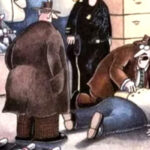
On the Philosophical Implications of Shelving Books
Or, the Time I Reorganized the Cook Books at BookCourt
Two years ago, I was working at BookCourt in the wake of a particularly crazed holiday shopping season. The store was empty in the way all of New York feels emptied out in January and July, and I spent several Sunday night shifts tidying unmussed shelves, listening to Sharon Van Etten on repeat. It was in this period, whether out of boredom, frustration, or a drive to find professional purpose, that I decided to rearrange the cookbook section—a vigilante mission I’m only now copping to, in this essay.
It’s important to note that, even outside of the holidays, most bookstores would look like a hoarder’s living room after an earthquake without the industriousness of booksellers. So much as a busy afternoon means books stacked sideways and face-down, the alphabet in shambles, but a good bookseller can shelve a book with one hand and organize overstock with the other, all while recommending a good starter Pynchon.
Cookbooks in particular are prone to orphanhood, pulled off the shelf by the half-dozen then left in a stack on the floor next to the couch. There are worse offenses than cookbook abandonment, but stray cookbooks leave especially heavy lifting for typically unmuscular booksellers, particular when General Cooking is organized by primary author and you can’t find where it says who wrote Cooking Light. For this and other reasons, what the section needed was an organizational overhaul—something less entropic and easier to browse.
At the outset, cookbooks were sorted into eight basic subsections: baking, healthy, French, Italian, Middle-Eastern, Spanish/Mexican, Indian, Mediterranean, and “general,” a catchall. This left fad diets dubiously under “healthy,” and a handful of Jewish cookbooks tucked in awkwardly at the end of Middle-Eastern, a collateral Zionism I found troubling. The section’s basic structure, I determined, was not sufficiently nuanced for the breadth and variety of cooking instruction on offer. (Cookbooks, after all, are the number-one best-selling genre in the US.) I laid out what I considered a thoroughly sensible system of organization, in seven sections: reference, general, celebrity (including restaurants), baking, cooking method, special diet, and ethnic/regional/national (alphabetical by demonym). We printed labels and re-stocked each book like elves, toiling while the children slept.
Even my improved system retained some holes—for instance, ought Mark Bittman to be shelved in general, reference, or celebrity? A case could be made for all three, but I settled on reference, partly to stick it to his “Everything” and partly because a true celebrity cookbook has a photograph on the front. Alice Waters landed in celebrity, but under “C” for Chez Panisse—a restaurant with celebrity of its own, at least at the cross-section of Brooklyn foodies and independent booksellers gone rogue.
In less than a day, the system was dismantled, either by the owner or the general manager. Our labels were torn off, and the section returned to a state even more primitive than where it started: general had swallowed healthy and baking, and Italian was tacked onto the tail end of Mediterranean—not wrong, but not helpful, either. Like an extreme faith, organizational logic necessarily denies the validity of any other system.
A system of organization, whatever its parameters, should render case-by-case choices obsolete: A book either is or is not a true-crime thriller, does or does not contain fiction, was or was not written by Agatha Christie. But in practice, every organizational schema is a doomed attempt to blanket chaos with order, and only more so the grander its ambitions. It may be possible to draw a sensible line delineating science from nature, art from design, autobiography from memoir, or war history from American history from Native American history, but to do so is to suggest that any one exists independently from the other. The clear lines bleed and become wobbly.
This may seem an unnecessarily deep philosophical hole to fall into at the question of where to shelve a roman à clef, but it is the essence of a slippery slope, and one easy to start down while staring at a wall of mystery books at 9 pm on a Sunday night with not a soul in the store, wondering what constitutes a mystery per se, and whether we ought to be shelving Gillian Flynn next to Tana French, and what about Patricia Highsmith? This is the bedrock of reason beginning to crack.
At such moments of ontological weakness, it occurs to the bookseller that there are any number of defensible methods of organizing books—by size, by color, by weight, by publisher. Most would be nonsense in a bookstore expected to function any way other than conceptually, and of no use to anyone not ordering books by the yard. Even alphabetical order can become a fragile exercise at the very briefest departure from the systemic norm; whether you believe the Divine Comedy belongs in poetry or a designated “classics” section (another pitfall), Dante should be shelved not under “D” but “A,” for “Alighieri.” But of course he isn’t, and never will be.
McNally Jackson Books, on Prince Street in Manhattan, organizes its literary fiction by author nationality—Bolaño in South America, Tolstoy in Russia, Zadie Smith in the United Kingdom. Biographies are alphabetical by subject, “except when the fame of the author exceeds that of the subject.” The Strand Bookstore, about a mile north on Broadway, sub-categorizes its history by era, and artfully cleaves essay collections and literary criticism into two distinct sections—a rare hospitality, even in New York City. At now-bygone BookCourt, independent publishers like New York Review Books, Melville House, and Europa Editions were once shelved in individual sections, the better to appreciate their careful list curation.
Such idiosyncratic filing systems may have edifying or aesthetic advantages, but the task of organizing books is one that grows in complexity the more one tries to simplify it. Jigsawing new, more delicately drawn puzzle pieces out of a given set of titles, however brainy, often creates more confusion than it erases, spiraling inward into subcategories of subgenres of co-authored anthologies that are impossible to browse.
This is particularly true of used bookstores, which are often at the mercy of their stock and subject to the organizational whims of the strange worms who become proprietors of such places. Another Country, an English-language bookstore in Berlin, holds a wall of books labeled VARYING DEGREES OF FICTION, while in the next room, a narrow shelf reads SACRED & PROFANE, where spine-cracked volumes of Michael Moore and E.L. James stand two books deep without any real clarity about what such a label means to express. An old meeting house in Deerfield, MA, once housed a sprawling used bookstore sifted into freewheeling categories like ECCENTRICITY, AUDACITY, AND UNCONVENTIONAL BEHAVIOR IN GENERAL, and a section on US history that warned politely, “Most of this case is shelved in rough chronological order.” Categorization is a fine science in these circles, and nuance a virtue; the oxymoronic “rough chronological” is the reasoned defeat of the veteran bookseller, hammering abstract pegs into concrete holes.
On Prince Street, Nabokov is shelved among his Russian compatriots, despite living much of his life as a Russian expatriate and writing his most famous work, Lolita, in English on a trip through the American West. And where does McNally’s biography section put Robert Caro’s Pulitzer Prize-winning The Power Broker, about Robert Moses? In a bookstore in New York City, on a spit of land that might well have become a freeway onramp had Moses had his way, whose fame exceeds whose—and to whom? The simplest fix would be to shelve two copies, one under “Caro” and one under “Moses,” but this would be no solution—it would be an admission of organizational defeat.
John Sherman
John Sherman is a writer and copy editor in Brooklyn. He has written for BOMB Magazine online, The Billfold, The Daily Dot, Brooklyn Magazine, and The L.



















